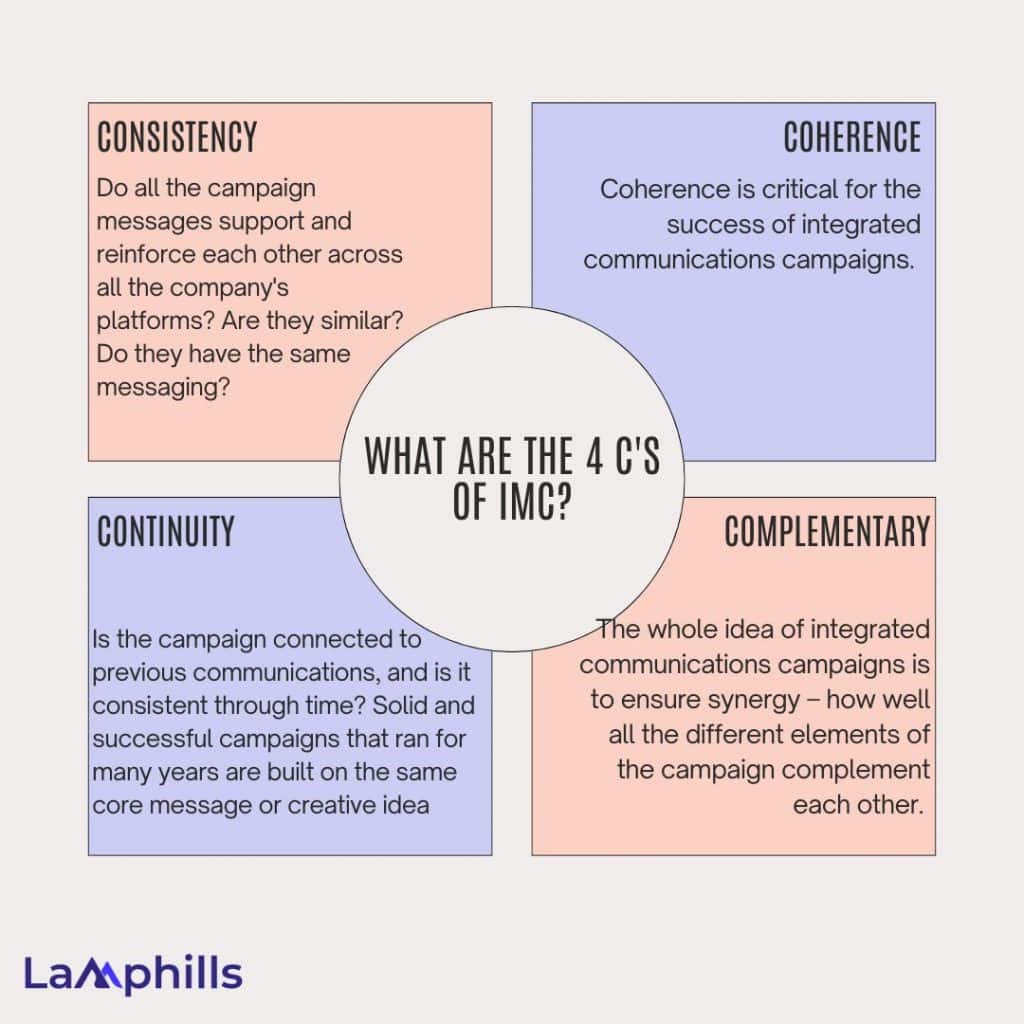A 2018 Gartner study found that integrated marketing campaigns with four or more digital channels perform 300% better than a dual-channel campaign. Additionally, related marketing communications are valuable to multiple audiences. First, they help create better consumer trust in a company and its values. Second, they benefit the organization’s stakeholders.
If a marketing team struggles to deliver a cohesive message, they likely don’t understand the essence of an integrated marketing approach. This article will further explain the concepts of integrated communication marketing and their examples.
Key Points
- Integrated Marketing Communications (IMC) is a strategic, collaborative, and promotional marketing function where a targeted audience receives consistent and persuasive brand messaging through various marketing channels in an integrated way to move buyers through the decision-making process.
- An integrated marketing communications strategy is a powerful business aspect that will help your business stand out.
- The most common IMC plans depend on what a company hopes to establish. They include external, internal, horizontal, and vertical.
- The 4Cs of integrated marketing communication include consistency, coherence, continuity, and complementary.
- The goals of integrated marketing communications campaigns include building trust, improving brand consistency, allowing for personalized marketing campaigns, and creating a competitive advantage.
What Is Integrated Marketing Communication?

The integrated marketing communication (IMC) process involves conveying a unified message across various channels to increase customer engagement for a company’s products and solutions. It marries public relations (PR), advertising, and marketing.
Imagine trying to discover a company’s mission or a brand’s message. If the sales team delivers different social media marketing team messages, consumers will find it hard to understand the organization’s truth. IMC seeks to eliminate these challenges and inconsistencies and ensure brands send the same signals regardless of team or priority.
That said, Integrated Marketing Communications (IMC) is a strategic, collaborative, and promotional marketing function where a targeted audience receives consistent and persuasive brand messaging through various marketing channels in an integrated way to move buyers through the decision-making process.
At the most basic level, integrated marketing communications help marketers use all available channels to amplify a marketing campaign and brand messaging to reach their target audience or buyer persona.
Integrated Marketing Communication Campaign Approaches
Different marketing plans have differing objectives. The most common IMC plans depend on what a company hopes to establish. They include:
- External: The company outsources its marketing activities to a marketing or public relations firm. The company tasks the outside agency with designing and developing effective IMC strategies to push its products and solutions to the market.
- Internal: Internal marketing involves creating an IMC plan in-house. The C-suite ensures that employees are excited about the new products under development. Employees may leak the details prematurely, garnering excitement from the market and prospective customers before a product launch.
- Horizontal: It brings together departments and prevents marketing teams from working autonomously – for instance, the product development and marketing departments. Creating open communication lines and sharing information between the two provides the collaboration teams required to build an effective and complete IMC strategy.
- Vertical: It demands that products under development fit in with policy and company structure. Therefore, new products must help the company work toward achieving its mission and goals.
What are the 4 C’s of IMC?

Marketers should consider the four Cs of IMC when creating successful integrated marketing campaigns. These principles of integrated marketing communications outline the four key concerns marketers must address to enable their campaign to achieve its goals. Below are the four Cs:
#1. Consistency
Do all the campaign messages support and reinforce each other across all the company’s platforms? Are they similar? Do they have the same messaging?
An IMC campaign must carry the same message across all platforms. Marketers must also extend the consistency test to other Ps (products, people, places, and promotions) and ensure they support and reflect the messaging.
One way to ensure consistency is to use a core campaign message, hashtag, or image. Marketers then take a step back and consider how to convey the same message across all media elements during the buyer’s journey, ensuring consistency throughout the campaign.
#2. Coherence
Are the different marketing communications logically connected? Can customers see one message in one place and another on a different platform and understand how the two relate? Or are they left wondering if they are addressing the same thing?
Coherence is critical for the success of integrated communications campaigns. Marketers need to test the coherence of their integrated marketing strategy on colleagues, family, and friends who haven’t been part of the campaign. Therefore, they should show them the different elements and ask if they can understand each other’s core message. They should also see if they can identify any differences in the messaging and whether they thought it was from one campaign.
#3. Continuity
Is the campaign connected to previous communications, and is it consistent through time? Solid and successful campaigns that ran for many years are built on the same core message or creative idea. They also use updated media and different ways of bringing the message to life.
The best way marketers can identify if their campaigns have continuity is to test with other people who are not part of the ideation process. They should show them the current and previous communications and campaign material and throw in a few random pieces from competitors. They should then ask which appears to be from the same company and how obvious it is.
#4. Complementary
The whole idea of integrated communications campaigns is to ensure synergy – how well all the different elements of the campaign complement each other. So it’s like a well-designed room where the various elements selected are interesting individually and work together as a whole.
When marketers step back and examine the elements of their communications, they should be amazed. Again, it’s best to test first on people before launching campaigns to see if they react with amazement.
5 Step Guide for Integrated Marketing Communication Across Channels
Integrated marketing campaigns are 31% more effective at brand building because they reach a more significant portion of the market. Leveraging the strength of each channel also means it’s an essential strategy if you need to convey a complicated brand message.
Did you know that research has found that integrated campaigns across 4+ channels are 300% more effective than single—or dual-channel campaigns?
So how can you do it? Getting started with an integrated marketing communication campaign is straightforward. Here are 5 steps to help your campaign succeed:
#1. Know Your Audience
Connecting with your audience is only possible if you understand who they are. You need to understand their motivational triggers, problems, and demographics. Research can reveal information such as age, gender, annual salary, hobbies, geographical location, and level of education. Gathering as much data as possible increases the effectiveness of targeted marketing campaigns.
Your audience will engage differently based on the marketing channel. Therefore, you’ll need to adapt the campaign message so it’s delivered with the most potency. However, the core brand message should never change since your audience may come across more than one of your marketing channels or campaigns over a long period of time.
#2. Crafting Your Message
Identify which part of the customer decision process you are tackling with this integrated marketing campaign. It’s a good starting point because you can brainstorm ideas at the right marketing funnel stage. For example, towards the start of the funnel, you might want to focus on problems or fears the customer is having. Towards the end of the funnel, you’ll focus on product benefits and unique selling points (hopefully not just price promotions!).
Integrated marketing messages should grab your audience’s attention and inspire them to share with their social circles. Crafting a compelling/emotional story is a great way to achieve this objective.
Look at successful examples for inspiration. “Always #LikeAGirl” is an excellent integrated marketing campaign that supports girls’ transition to womanhood during puberty. The campaign focuses on overcoming the negative connotations of the phrase “like a girl.” It uses social media, print, and television to deliver its message.

#3. Actionable Goals
Use SMART goal setting to increase your chances of success by 70%. Here is a breakdown of what this involves:
Specific: this stage is about asking the popular “w” questions (who, what, why, where, when) and having clear answers. Being specific ensures you have something to aim for, which can be used to track progress. Team members can visualize goals, which allows them to push forward.
Measurable: to achieve a goal, there must be a way of measuring it. This might be looking at how many new email subscribers you receive or how many YouTube sales you generate for marketing videos. Tracking across multiple channels is also advantageous.
Achievable: Unrealistic goals can be overwhelming, preventing people from taking action. Consider your resources, deadline, and personnel to craft realistic goals. It might take trial and error before you can set goals you know can be achieved within your deadline. Also, consider setting mini-goals that regularly give team members a sense of accomplishment. Agencies can be used to scale efforts or close the skills gap with your in-house team.
Relevant: Choose goals that help grow your brand, increase market share, and improve profitability. Not thinking about goal relevancy may cause your marketing team to pursue key performance indicators incorrectly. You’ll waste resources and time that could have been better spent.
Time-bound: goals that drag on for a long time can do more harm than good. Set a realistic deadline that represents a steady company growth rate. Setting a deadline ensures action is taken sooner rather than later.
Read also: SMART SALES GOALS: How To Set Them With Examples
#4. Choose Your Channels Wisely
In an ideal world, you could explore every marketing channel to its full potential. However, you probably have a finite marketing budget, so you need to choose your omnichannel marketing strategy carefully. This is where understanding your audience comes in handy.
Where are they hanging out, and what media channels are they paying attention to? When are they consuming media — on the commute to work or when they get home in the evening?
Answering these questions will help you choose the right marketing channels and grab attention at the right time. You’ll make the most of a limited marketing budget essential for small to medium-sized companies.
#5. Track Your Campaigns

Choose the tools and software to monitor your integrated marketing campaign progress closely. You can opt for tools like Google Data Studio to pull information from every channel. Knowing what works and what doesn’t allows you to focus on the areas that need improvement.
Before buying, a customer might read an email, click on a Google ad, watch a video, or read a social media post. An attribution model for conversion tracking will help make sense of the customer journey by assigning weight to the marketing channel responsible for the sale. The model is more difficult to implement than on paper, but the data gathered can paint a full picture of channels to focus on.
Don’t forget about measuring traditional advertising performance. The “before and after” method can be used to see the difference in sales before running a campaign and just after. The limitation of this tracking method is that for a true test, only one campaign can be run at a time. Code-specific campaigns also help track performance since sales can be linked to coupons and campaign-specific phone numbers.
Check out our free marketing plan template:
Lamphills Marketing Plan Template
Integrated Marketing Communication Examples
Here are some examples of successful Integrated Marketing Communication (IMC) strategies:
#1. GoPro: Be a Hero Campaign
To advertise its durable action Hero cameras, GoPro launched the ‘Be a Hero’ campaign, which turned its users into brand ambassadors. People submitted user-generated content, such as footage of themselves using their cameras to do everything from extreme sports to everyday things, like swimming in a pool.
GoPro used the “Be a Hero” messaging across multiple channels: in TV ads, on billboards, on social media, and in digital communications. The campaign resonated with so many since it evoked the idea that anyone could be a hero with a GoPro camera, an idea that helped the brand reach a whole new audience.
#2. Domino’s: AnyWare Campaign
To draw attention to how easy it is to order a pizza from Domino’s, the company launched its ‘AnyWare’ campaign. This campaign allowed customers to order via text and tweet, and even on smart devices like watches, TVs, and voice-activated AI devices like Alexa. To do this, customers had to set up a pizza preference profile online to facilitate quick ordering.
Domino’s used an integrated marketing communication strategy to promote this campaign on social media, TV ads, and press releases, driving traffic to its website to learn more about quick ordering. The pizza giant set a goal of having half of all its orders placed digitally, which it readily achieved through this campaign.
#3. Dove: Campaign for Real Beauty
What started as a study of how women and society perceive female beauty became a global campaign that helped redefine a brand. Dove began by releasing billboard ads asking people to text in a vote whether the women portrayed in the ads were beautiful or not. This extended into similar marketing messages on viral videos, TV commercials, print ads, and social media.
Dove went from a simple soap company to a brand synonymous with body positivity, making it a great example of using integrated marketing to rebrand. With this campaign, Dove managed to spark a conversation to repurpose its brand and increase its sales from $2.5 billion to $4 billion in the 10 years following its release.
#4. Coca-Cola’s “Share a Coke” Campaign

Coca-Cola launched a campaign that printed common first names on their bottles and cans. The campaign extended across various T.V., print, outdoor, and digital channels. It encouraged customers to find their names (or their friends’ names) and share the experience on social media using the #ShareaCoke hashtag. This integrated approach resulted in massive engagement and boosted Coke’s sales after over a decade of decline in Coke consumption in the U.S.
What Is the Goal of the Integrated Marketing Communication Campaign?
An integrated marketing communications campaign ensures customers receive the same message when interacting with a company’s marketing channels. Below are the advantages of integrated marketing communications campaigns:
#1. Builds Trust
Integrated marketing campaigns focus on building a relationship with the customer. Companies try to build rapport by increasing their brand awareness and improving their reputation. Successful integrated communications campaigns get customers talking about the brands and their products in casual conversations, similar to mentioning seeing a new movie or running into an old friend.
An IMC campaign strategy helps build trust between brands and their customers. Messaging that values and pursues consistency and clarity will result in more understanding from the target audience. An organization’s various departments must say and share the same message. Hence, consumers know who to trust.
#2. Improves Brand Consistency
One significant benefit of IMC is that marketers can effectively communicate a consistent brand story and messaging across various communication channels to create awareness.
Consumers spend more time on PCs and mobile devices, so marketers seek to weave together multiple brand exposures using different touchpoints but with the same messaging. Companies can then review their entire IMC campaign performance rather than as fragmented pieces.
#3. Allows for Personalized Marketing Campaigns
Companies that send targeted marketing messages have increased brand loyalty. For example, sending customers birthday messages and well wishes or addressing them by their first name via email goes a long way in creating positive experiences about the company.
Personalized communications extend to more than personalized email messages. They also involve loyalty programs that reward customers with offers or limited-time discount campaigns.
#4. Creates Competitive Advantage
IMC creates a competitive advantage for SMBs looking to boost their sales and profits. SMBs usually operate on a smaller marketing budget with limited staff. Therefore, they can use IMC to immerse customers in communications and help move them through the various buying process stages. As a result, SMBs can simultaneously consolidate their image, develop a dialogue, and nurture relationships with customers throughout the exchange.
What are the Primary Tools for Integrated Marketing Communications?
Integrated marketing communications methods are the promotional tools marketers use to push content. These include the following:
- Public relations
- Internet marketing (content marketing, SEO tactics, webinars, blogs, etc.)
- Advertising (TV ads, online ads, banners, newspapers, billboards, etc.)
- Direct marketing
- Sales promotion
Marketers must choose the right mix of traditional and digital communication tools to build a solid brand-consumer relationship with the target audience. Regardless of the tools marketers use, they must push consistent and credible messaging across all the channels.
Bottom Line
An integrated marketing communications strategy is a powerful business aspect that will help your business stand out. Stronger brand messaging that drives your customer reach and engagement will positively impact your ROI and bottom line.
Marketing can be challenging, especially when target audiences are increasingly challenging to isolate and identify. We now need to reach them across different platforms and channels, ensuring we produce specific content they find interesting and valuable. Developing an IMC can keep things straightforward and moving in the right direction.
Similar Articles
- What Does Integrated Communications Marketing Do For Your Business: All You Need To Know
- Marketing Communications: Strategies to Amplify Your Brand’s Voice
- Integrated Communication in the Digital Age
- Executive Communications: Strategies for Leaders to Inspire and Influence






